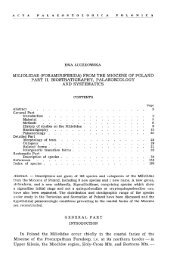Full text - Acta Palaeontologica Polonica
Full text - Acta Palaeontologica Polonica
Full text - Acta Palaeontologica Polonica
You also want an ePaper? Increase the reach of your titles
YUMPU automatically turns print PDFs into web optimized ePapers that Google loves.
CAZE ET AL.—COLOUR PATTERNS IN AMPULLINIDAE 343<br />
levels of residual colouration. The background is dark and<br />
homogeneous, the apical whorls appear paler than the rest of<br />
the spire but are rarely preserved and there are some axial flu−<br />
orescent stripes (Fig. 8A, B). The axial stripes, straight to sin−<br />
uous and slightly prosocline (Fig. 8A1,B2), are only observ−<br />
able on the spire. The width of the stripes is equivalent to that<br />
of their interspaces and their distribution is regular. This re−<br />
sidual colour pattern is very similar to those of Pachy−<br />
crommium productum (Deshayes, 1864) from the Lutetian of<br />
the Paris Basin (Fig. 8C), Pachycrommium sp. from the<br />
Ypresian of the Paris Basin (Fig. 8D) and Pachycrommium<br />
hybridum (Lamarck, 1804) from the Bartonian (Auversian)<br />
of the Paris Basin.<br />
Pachycrommium scalariformis (Deshayes, 1825)<br />
Fig. 8E, F.<br />
Stratigraphic and geographic range.—Middle Eocene, Lute−<br />
tian (PB, HB).<br />
Colour pattern description.—The colour pattern consists of a<br />
dark and homogeneous background and broad axial slightly<br />
fluorescent stripes (Fig. 8E, F). These stripes appear straight<br />
on the spire but present saw−tooth edges. They actually form<br />
zigzags spreading over the whole height of the whorl. Their<br />
width is not constant (Fig. 8F).<br />
Pachycrommium acuminatum (Lamarck, 1804)<br />
Fig. 9A–H.<br />
Stratigraphic and geographic range.—Middle Eocene, Lute−<br />
tian (PB).<br />
Colour pattern description.—This species show three levels<br />
of residual colouration: a dark and homogeneous back−<br />
ground, a pale apex and fluorescent rows of small axial co−<br />
alescent segments. These fluorescent and thin segments very<br />
close to each other form small zigzags and are more or less<br />
elongated. Their width is not constant (Fig. 9B2,F2,G2). The<br />
coalescence produces, on the subsutural step, broad triangu−<br />
lar fluorescent patches. The segments are often opisthocline<br />
and the frequency of the zigzags varies among individuals<br />
(Fig. 9B2, C, G2, H2). Pachycrommium eburnoides (Grateloup, 1847)<br />
Fig. 9I–K.<br />
Stratigraphic and geographic range.—Oligocene, Chattian–<br />
Miocene, Burdigalian (AB).<br />
Colour pattern description.—The pattern consists of three<br />
levels of residual colouration. The background is dark and<br />
homogeneous, the apex is pale and there are broad axial fluo−<br />
rescent stripes (Fig. 9I, J, K3). The stripes are broader than<br />
the interspaces and their width increases with growth (Fig.<br />
9I2). Their distribution is regular and they may be straight<br />
(Fig. 9I1) or sinuous (Fig. 9J1). Some specimens from Dax<br />
(Fig. 9J, K) display an additional level of colouration: some<br />
patches much darker than the background, more or less axi−<br />
ally compressed, with irregular distribution and often coales−<br />
cent (Fig. 9J2, K).<br />
Ampullinid−like gastropods of uncertain affinity<br />
Genus Ampullonatica Sacco, 1890<br />
Type species: Ampullaria ambulacrum Sowerby, 1822, Barton, Barto−<br />
nian.<br />
Description.—No residual colour pattern is observed under<br />
UV light.<br />
Remarks.—This genus comprises 5 worldwide Cainozoic<br />
species (SOM 1). Two of the studied species of Ampullo−<br />
natica, A. ambulacrum (Sowerby, 1822), and A. brongniarti<br />
(Deshayes, 1864) from the Bartonian of England and France<br />
(HB, PB; SOM 2), are characterised by an acuminate and<br />
moderately high spire turreted by a deeply canaliculated su−<br />
ture, a large and deep umbilicus with an undistinguishable<br />
sheath and a thin and narrow columellar edge. This shell<br />
morphology is similar to the shell morphology of the enig−<br />
matic taxon Amauropsina.<br />
?Ampullonatica gouberti (Deshayes, 1864), described on<br />
the basis of a unique specimen from the Bartonian of France,<br />
displays unusual shell morphology (very strong shoulder,<br />
very low spire) and might be a teratological specimen of an<br />
already known species (e.g., Ampullina parisisiensis).<br />
Genus Amauropsina Bayle in Chelot, 1885<br />
Type species: Ampullaria canaliculata Lamarck, 1804, Grignon, Lute−<br />
tian.<br />
Description.—The two Palaeogene species of this genus<br />
(SOM 1, 2) display various morphologies of the colour pat−<br />
tern varying from fluorescent patches more or less regularly<br />
positioned on a darker background to axial fluorescent seg−<br />
ments formed by coalescence of these patches.<br />
Remarks.—The morphology of the species of Amauropsina<br />
(elevated and acuminate spire, large umbilicus without<br />
sheath, narrow columellar edge somewhat reflected and, in<br />
the type species a narrowly canaliculated suture) is not repre−<br />
sentative of the Naticidae. This rather resembles the shell<br />
morphology of the ampullinid genus Ampullonatica (no re−<br />
sidual pattern under UV light). However, the colour pattern<br />
of A. arenularia is similar to that revealed in Eocene naticids<br />
(Le Meur 2009) and that of A. canaliculata displays sparse<br />
small fluorescent patches, unknown from other naticids and<br />
even from other ampullinids. Interpretations of the system−<br />
atic affinity of this genus derived from shell morphology and<br />
colour pattern data differ and so the genus Amauropsina re−<br />
mains an enigmatic taxon.<br />
Amauropsina canaliculata (Lamarck, 1804)<br />
Fig. 10A–D.<br />
Stratigraphic and geographic range.—Middle Eocene, Lute−<br />
tian–Bartonian (Auversian) (PB, HB).<br />
Colour pattern description.—The pattern consists of three<br />
levels of residual colouration: a dark and homogeneous<br />
background, a pale apex and small fluorescent patches (Fig.<br />
10A–C). The small patches are of variable size and shape and<br />
present an irregular distribution (Fig. 10B1, C). There is<br />
doi:10.4202/app.2009.0084
















